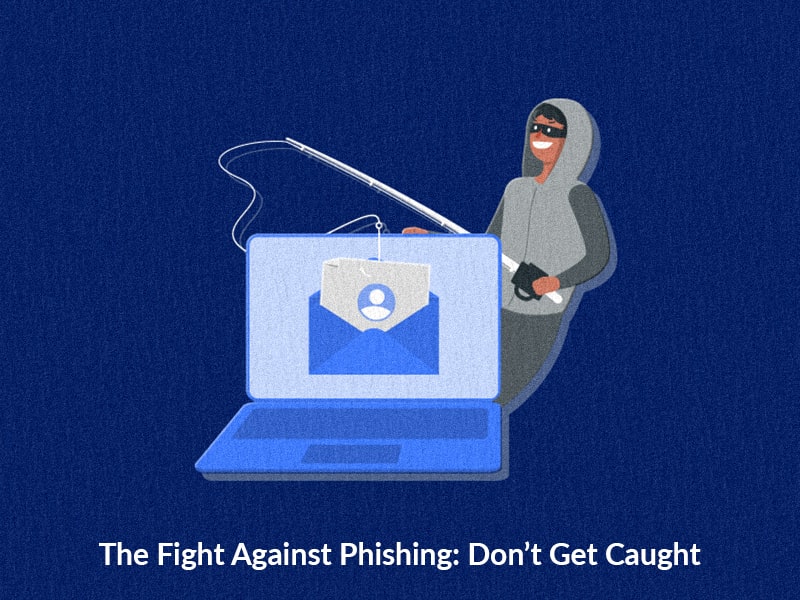Every day, there's some form of cybercrime in the headlines. According to a recently published report (#1), phishing hit 94% of organizations, and a whopping 96% felt the negative impact. There’s no better time than now to adapt your approach towards cyber security. Cybersecurity defends against cyber threats and boosts business trust. It keeps things private, intact, and available. It also defends against sneak peeks and cyber threats. These cyber pillars aren't just defenders; they boost business, comply with rules, and preserve that trust in your brand. In this article, we’ll discuss more about phishing, some stats, case studies, and how you can defend yourself against them.

Understanding Phishing
Phishing is one of the trickiest cyber attacks, employing deceptive tactics to lure individuals into revealing sensitive information-be it login credentials, personal details, or financial data. The term "phishing" borrows from the art of fishing, where bait is strategically cast to entice individuals into unwittingly disclosing confidential information.
Goals of Phishing
- Credential Theft: Unearthing usernames, passwords, or authentication credentials.
- Financial Fraud: Gaining illicit access to financial information for unauthorized transactions.
- Identity Theft: Acquiring personal information to impersonate the victim.
- Malware Distribution: Propagating malicious software to compromise devices or networks.
Diverse Forms of Phishing
Email Phishing
- Description: Crafty emails mimic legitimate sources like banks or government agencies.
- Objective: Deceptively lead recipients into clicking malicious links or divulging sensitive information.
Spear Phishing
- Description: Precision-focused attacks targeting specific individuals using personalized information.
- Objective: Steal sensitive information or gain access to specific accounts.
Vishing (Voice Phishing):
- Description: Imagine a scenario where someone calls you up, not with friendly intentions, but to use clever social engineering tactics to pull sensitive information out of you. This is what we refer to as Vishing, a term derived from "voice phishing." It's simply a conversation over the phone, where the caller is on a mission-to get hold of your personal or financial details through the power of their voice.
- Objective: Their goal? Well, it's quite straightforward. They want to paint a convincing narrative, one that tricks you into sharing personal or financial details during the course of a seemingly ordinary conversation. In the end, the unsuspecting victim ends up revealing more than they intended.
Smishing (SMS Phishing)
- Description: Now, picture another scenario-this time involving your trusty mobile device. You receive a text message, and it seems harmless at first. Often the texter pretends to have sent the text to the wrong number and then attempts to lure you into a conversation.
- Objective: The objective here is to play on your trust in text messages, luring you into providing sensitive information without a second thought. It's like a textual sleight of hand, where the sender manipulates words to deceive you into sharing valuable details through SMS. So, next time your phone pings with an unexpected message, stay vigilant-Smishing might be trying to make its move.
Pharming
- Description: Fraudulent websites or manipulated DNS settings redirect users to malicious sites.
Objective: Capture sensitive information, such as login credentials.
Clone Phishing
Description: Exact replicas of legitimate emails modified to include malicious content.
Objective: Convince recipients of legitimacy, leading them to take malicious actions.
Whaling/CEO Fraud
- Description: Targeting high-profile individuals, such as executives, to initiate specific actions.
- Objective: Financial gain or unauthorized access to sensitive corporate data.
Watering Hole Attacks
- Description: Compromising frequented websites to infect visitors with malware.
- Objective: Exploit trust in compromised websites to deliver malware or capture login credentials.
Man-in-the-Middle (MitM) Attacks
- Description: Intercepting and potentially altering communication without the parties' knowledge.
- Objective: Capture sensitive information like login credentials or financial details.
Business Email Compromise (BEC)
- Description: Compromising business email accounts for financial fraud.
- Objective: Achieving financial gains through fraudulent transactions or unauthorized access.
Phishing Attack Statistics
- Phishing, the predominant cyber crime, entails a staggering estimated 3.4 billion malicious emails daily, skillfully crafted to resemble trusted sources. (#2)
- Approximately 36% of data breaches involve phishing.
- In 2022, a striking 84% of organizations encountered at least one phishing attempt.
- The Anti-Phishing Working Group logged over 4.7 million phishing attacks in 2022, marking a drastic 150% yearly increase since 2019.
- Spear phishing campaigns demonstrated an average click rate of 53.2%.
- Notably, 29.82% of spam emails in 2022 originated from Russia, with China and the United States trailing at 14% and 10.71%, respectively.
Anatomy of Phishing
Imagine receiving an email that's not just another message in your inbox but one that's trying to nudge you into a specific action. It's like a persuasive note, urging you to open an attachment that, unbeknownst to you, carries the potential to unleash chaos on your computer and network. We're talking about malware, and not just any malware-something as sinister as ransomware.
This email might not stop there. It could be on a mission to push you into a corner, subtly coercing you to part with your hard-earned money. It's like a digital con artist, manipulating words and urgency to make you feel compelled to make a payment. So, next time you come across an email that seems a bit too insistent or prompts you to take immediate action, tread carefully. It could be a digital threat trying to lure you into scams like phishing.
Consequences of Phishing Attack
Loss of Customers:
- Successful phishing attacks instill fear, prompting more than half of consumers to cease patronizing a hacked organization for several months after a data breach.
Financial Penalties:
- When sensitive customer data lands in the public domain, repercussions include direct monetary losses and hefty regulatory fines for mishandling data.
Intellectual Property Theft:
- The compromise of research, development, and trade secrets sets businesses back, making them less competitive.
Loss of Company Value:
- A phishing attack can erode a significant part of a company's market value, stemming from the loss of investor confidence, and leading some to divert their funds elsewhere to protect their portfolio.
Phishing Attack: Case Studies
Twitter Phishing Case (2020):
- Spear phishing attacks on Twitter employees enabled malicious actors to reset high-profile accounts for Bitcoin scams, resulting in substantial transfers from users.
Facebook (2015):
- A phishing exploit capitalized on a third-party vendor, utilizing fake invoices to extract a significant sum.
Crelan Bank:
- Falling victim to a Business Email Compromise (BEC) scam, the bank incurred substantial losses.
FACC (2016):
- An aerospace parts manufacturer faced a BEC scam, resulting in a sizable financial loss.
Upsher-Smith Laboratories (2014):
- A drug company experienced a BEC attack, losing over $39 million due to the impersonation of their CEO.
Recognize & Prevent Phishing Attack
Verify Sender Information:
- Scrutinize email addresses and domain names for subtle alterations, even if they seem to originate from a trusted sender.
Check for Typos:
- Be wary of grammatical errors and typos, often indicative of phishing attempts.
Avoid Sharing Sensitive Information:
- Emails requesting sensitive information should raise suspicion; verify directly with the institution via phone.
Beware of Urgency:
- Phishing emails thrive on urgency and authority; scrutinize requests for immediate action.
Hover, Don't Click:
- Hover over URLs to verify legitimacy before clicking to ensure security.
Exercise Caution with Attachments:
- Hover over attachments to confirm legitimacy before downloading; refrain from clicking if uncertain.
Be Skeptical of Too-Good-To-Be-True Offers:
- If an offer seems too good to be true, exercise caution as it may be a phishing ploy.
Keep Devices Updated:
- Regularly update devices and applications to bolster defenses against vulnerabilities.
Regularly Check Accounts:
- Monitor accounts frequently to detect any unauthorized changes promptly.
Report Suspected Compromises:
- If there's any doubt about the security of work devices or data, promptly inform the relevant authorities.
References for Statistics
- # 1 : https://pages.egress.com/whitepaper-email-risk-report-01-24.html
- #2 : https://www.stationx.net/phishing-statistics
Final Thoughts
By integrating these practices into daily digital interactions, individuals and organizations fortify their defenses against phishing attacks, ensuring the safety and integrity of sensitive information. If you like what you just read, you should subscribe to our newsletter where we send you fresh insights every week!



